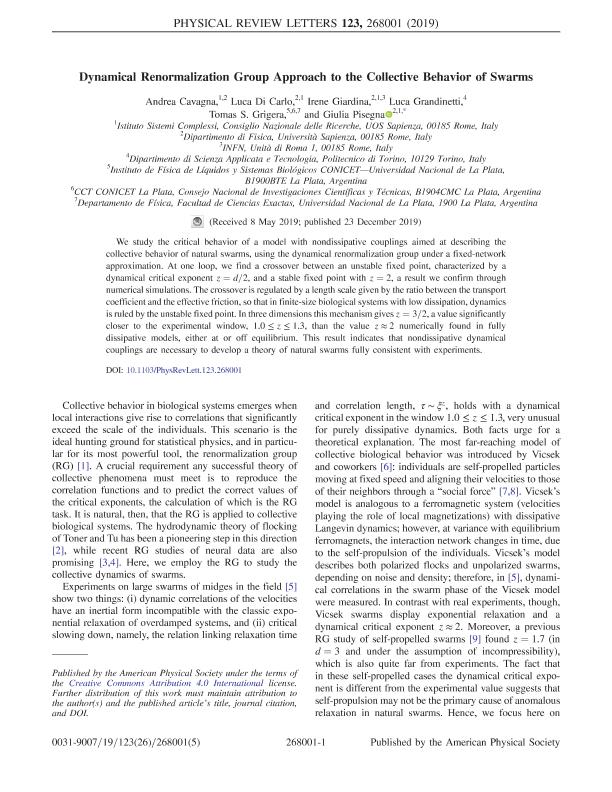Mostrar el registro sencillo del ítem
dc.contributor.author
Cavagna, Andrea

dc.contributor.author
Di Carlo, Luca
dc.contributor.author
Giardina, Irene
dc.contributor.author
Grandinetti, Luca
dc.contributor.author
Grigera, Tomas Sebastian

dc.contributor.author
Pisegna, Giulia

dc.date.available
2021-02-12T18:54:18Z
dc.date.issued
2019-12-23
dc.identifier.citation
Cavagna, Andrea; Di Carlo, Luca; Giardina, Irene; Grandinetti, Luca; Grigera, Tomas Sebastian; et al.; Dynamical Renormalization Group Approach to the Collective Behavior of Swarms; American Physical Society; Physical Review Letters; 123; 26; 23-12-2019; 1-5
dc.identifier.issn
0031-9007
dc.identifier.uri
http://hdl.handle.net/11336/125629
dc.description.abstract
We study the critical behavior of a model with nondissipative couplings aimed at describing the collective behavior of natural swarms, using the dynamical renormalization group under a fixed-network approximation. At one loop, we find a crossover between an unstable fixed point, characterized by a dynamical critical exponent z=d/2, and a stable fixed point with z=2, a result we confirm through numerical simulations. The crossover is regulated by a length scale given by the ratio between the transport coefficient and the effective friction, so that in finite-size biological systems with low dissipation, dynamics is ruled by the unstable fixed point. In three dimensions this mechanism gives z=3/2, a value significantly closer to the experimental window, 1.0≤z≤1.3, than the value z≈2 numerically found in fully dissipative models, either at or off equilibrium. This result indicates that nondissipative dynamical couplings are necessary to develop a theory of natural swarms fully consistent with experiments.
dc.format
application/pdf
dc.language.iso
eng
dc.publisher
American Physical Society

dc.rights
info:eu-repo/semantics/openAccess
dc.rights.uri
https://creativecommons.org/licenses/by/2.5/ar/
dc.subject
Collective behavior
dc.subject
active matter
dc.subject
renormalization group
dc.subject.classification
Otras Ciencias Físicas

dc.subject.classification
Ciencias Físicas

dc.subject.classification
CIENCIAS NATURALES Y EXACTAS

dc.title
Dynamical Renormalization Group Approach to the Collective Behavior of Swarms
dc.type
info:eu-repo/semantics/article
dc.type
info:ar-repo/semantics/artículo
dc.type
info:eu-repo/semantics/publishedVersion
dc.date.updated
2020-11-19T21:55:51Z
dc.journal.volume
123
dc.journal.number
26
dc.journal.pagination
1-5
dc.journal.pais
Estados Unidos

dc.description.fil
Fil: Cavagna, Andrea. Consiglio Nazionale delle Ricerche; Italia. Università Degli Studi Di Roma "la Sapienza". Dipartimento Di Sanita Publica E Malattie Infetive; Italia
dc.description.fil
Fil: Di Carlo, Luca. Consiglio Nazionale delle Ricerche; Italia. Università Degli Studi Di Roma "la Sapienza". Dipartimento Di Sanita Publica E Malattie Infetive; Italia
dc.description.fil
Fil: Giardina, Irene. Consiglio Nazionale delle Ricerche; Italia. Università Degli Studi Di Roma "la Sapienza". Dipartimento Di Sanita Publica E Malattie Infetive; Italia. Istituto Nazionale Di Fisica Nucleare; Italia
dc.description.fil
Fil: Grandinetti, Luca. Politecnico di Torino; Italia
dc.description.fil
Fil: Grigera, Tomas Sebastian. Consejo Nacional de Investigaciones Científicas y Técnicas. Centro Científico Tecnológico Conicet - La Plata. Instituto de Física de Líquidos y Sistemas Biológicos. Universidad Nacional de La Plata. Facultad de Ciencias Exactas. Instituto de Física de Líquidos y Sistemas Biológicos; Argentina
dc.description.fil
Fil: Pisegna, Giulia. Consiglio Nazionale delle Ricerche; Italia. Università Degli Studi Di Roma "la Sapienza". Dipartimento Di Sanita Publica E Malattie Infetive; Italia
dc.journal.title
Physical Review Letters

dc.relation.alternativeid
info:eu-repo/semantics/altIdentifier/url/https://link.aps.org/doi/10.1103/PhysRevLett.123.268001
dc.relation.alternativeid
info:eu-repo/semantics/altIdentifier/doi/http://dx.doi.org/10.1103/PhysRevLett.123.268001
Archivos asociados
